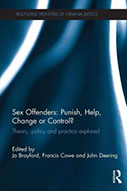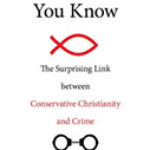Sex Offenders: Punish, Help, Change, or Control?

Editors: Jo Brayford, Francis Cowe, and John Deering
Publisher: London; New York: Routledge, 2012. 368p.
Reviewer: Amber L. Morczek | May 2015
Sex Offenders: Punish, Help, Change or Control isa judiciously assembled collection of edited works that offers readers socio-historical contextual information on sex offending behavior, policy, and practice coupled with an appropriately exhaustive overview of some of the most recent sex offender research. Though Brayford, Cowe, and Deering’s text may be slightly less palatable for an inexperienced reader, the book is completely appropriate for advanced social science graduate students, a variety of other individuals in academia, and those in professional criminal justice settings who are seeking a plethora of complex information on sex offender behavior, policy, and legislation, both at home and abroad.
This book is a topical pantry, examining a wide array of subjects necessary to better understand and contextualize sexual offending. It should be noted that while the bookmaybe most suitable for readers in the United Kingdom, given the academic and professional backgrounds of many of the contributing European scholars, it would nonetheless be beneficial to those elsewhere, as it contains a wealth of cross-cultural data. To be clear, this sentiment isn’t a criticism of the authors’ backgrounds or (obviously thorough) knowledge base and should not detract from the value of the book and the works contained therein.
The text is organized into four sections with edited chapters therein. The first section, “Setting the Scene,” is constructed as a multifaceted introduction, setting the appropriate historical backdrop and context for subsequent chapters. The authors immediately denote how sex offender policy is largely reactionary, rather than proactive — offering mainly post-offense control measures rather than comprehensive preventive strategies or tangible attempts to understand the pathways to offending. In fact, the book’s central argument is that sex offenders are not a homogenous group (as the ill-informed general public, so-called black swan media representations, and hastily implemented policy would lead us to believe), but are rather a diverse group of individuals whose offending patterns are varied and complex. Although highly reactionary “get tough” sex offender policy may satiate the public’s desire for retribution and feelings of security, it is noted that these strategies have significant collateral consequences for both offenders and the community.
The second section, “Types of Offenses and Victims,” speaks to the editor’s topical dexterity and complements the preceding chapters by examining the diverse nature of both victims and offenders. More specifically, the editors cleverly include subtopics that deviate from the traditional discourse involving child-based contact offenses perpetrated largely by men. These subtopics include: female sex offenders, offenders who abuse animals, offenders who use the internet as their primary means of abuse, and finally, the vulnerability of certain classes of people including those with learning difficulties. Although it may ostensibly appear to be a hodgepodge of essays, this section truly addressed some of the outlying subjects that, while certainly falling under the umbrella of sex offending, may be considered ancillary to more prominent lines of scholarly inquiry.
The final sections of the book explore policy and practice. The chapters included therein are fruitful, especially for those seeking information on sex offender treatment as well as policy recommendations. In the concluding chapter, editors of the text summarize how we can learn from our previous shortcomings to craft both proactive and reactive sex offender policy and practice.
All in all, Sex Offenders: Punish, Help, Change or Control is skillfully organized, scrupulously researched, remarkably comprehensive, and palatably verbose. It appropriately fills information gaps other texts on sexually-based offenses may purposefully overlook. Indeed, Brayford, Cowe, and Deering have been undeniably successful at constructing “more than just a series of edited collections” (p. 3), and this text will surely prove useful in a variety of contexts and to a variety of audiences.
Amber L. Morczek, PhD Candidate, Washington State University, Department of Criminal Justice and Criminology


